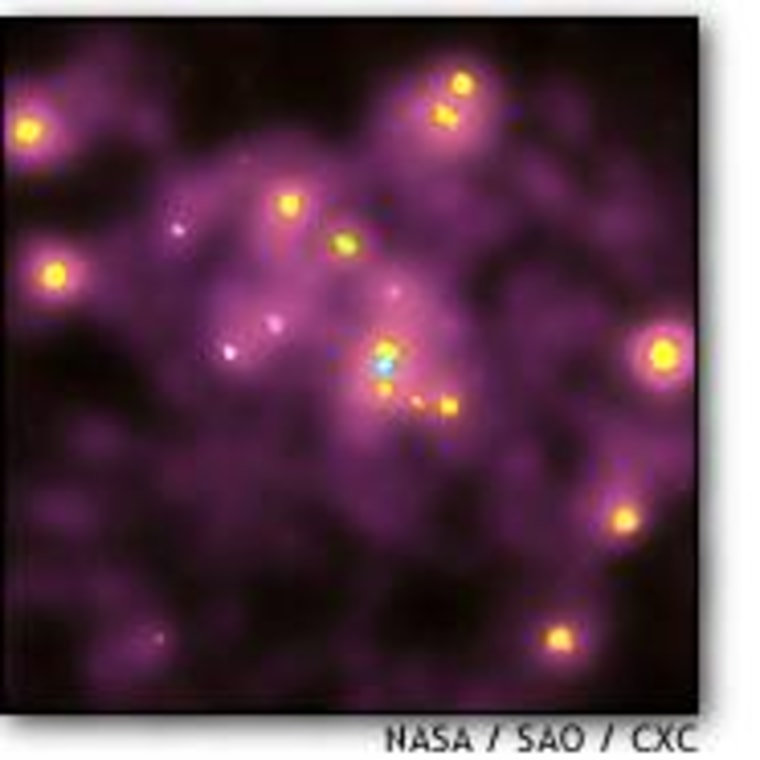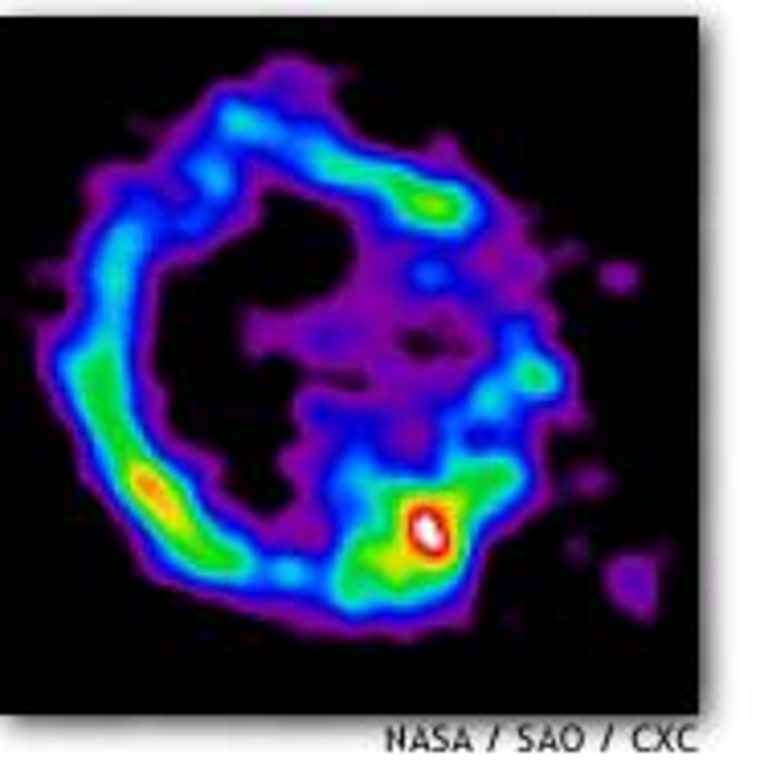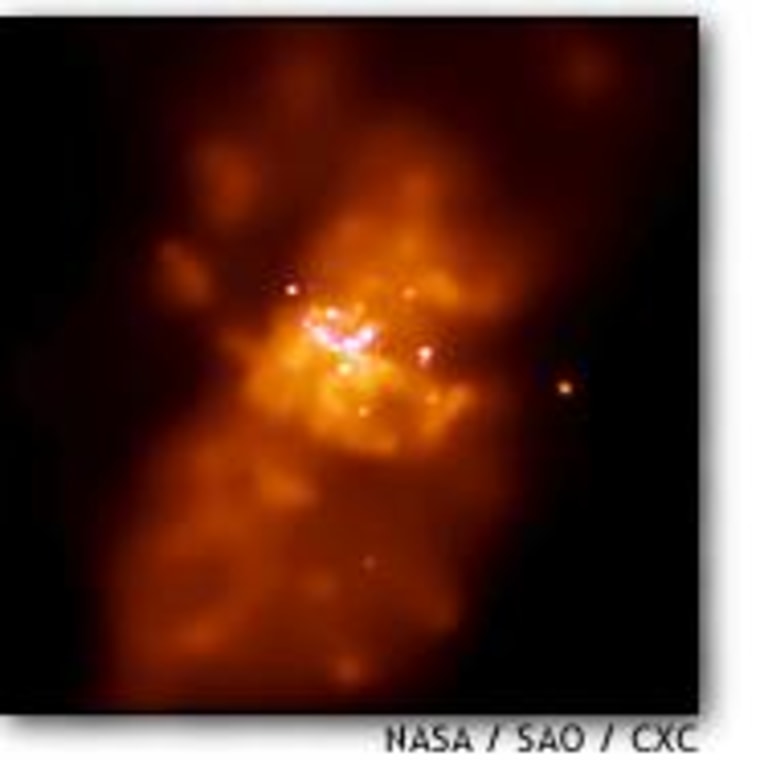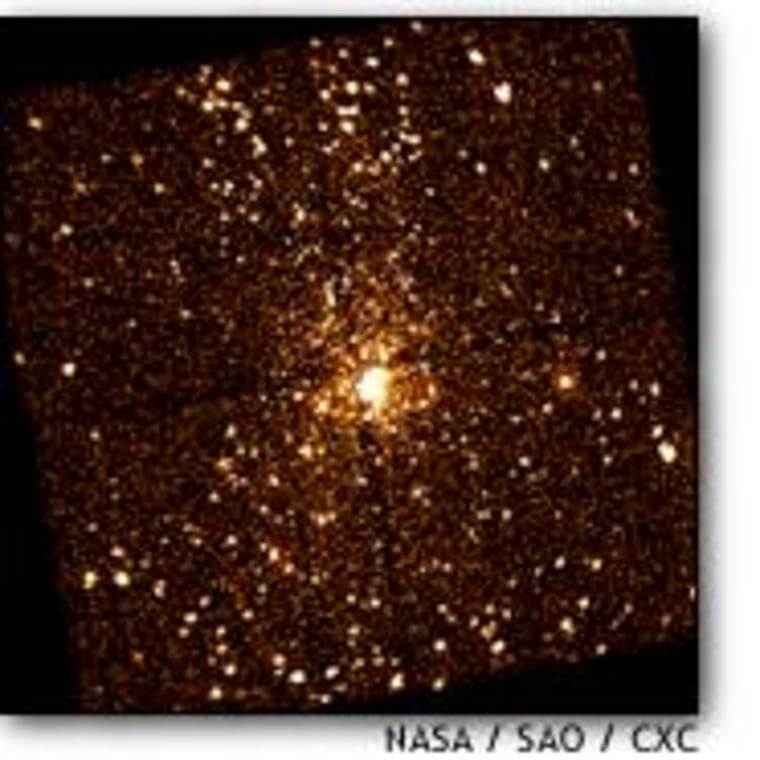In the first formal scientific findings from NASA’s Chandra X-Ray Observatory, astronomers are adding to their menagerie of black holes and other violent phenomena. Among the exhibits unveiled Friday: the quiet black hole that may lie at the center of our own galaxy ... the coolest black hole ever detected, found in a neighboring galaxy ... a supernova spewing the stuff of life ... and showers of starbursts.

THE $1.5 BILLION X-ray telescope, named after Indian-American astrophysicist Subrahmanyan Chandrasekhar, is designed to observe explosive events such as black holes and supernovae from an eccentric orbit high above Earth’s atmosphere, which filters out the cosmic X-rays.
Chandra was sent into orbit last July during a space shuttle mission, and the first images were released just a month later. But this week’s presentations at the winter meeting of the American Astronomical Society in Atlanta represent the first formal presentations based on the telescope’s observations.
During a preview on Thursday, during the winter meeting of the American Astronomical Society in Atlanta, researchers released data about faint X-ray sources that could represent black holes on the edge of the observable universe.
The windfall of wonders continued during Friday’s presentations:
OUR GALAXY’S BLACK HOLE
Scientists believe that most galaxies, including our own Milky Way, are anchored by a central black hole - a collapsed region so dense that nothing, not even light, can escape its gravitational pull. However, that doesn’t mean there’s nothing going on around the black hole. In fact, the energy generated by matter swirling into the hole generally translates into powerful X-ray emissions.
That posed a puzzle for astronomers: Despite 25 years of searching, they were never able to detect the X-ray source associated with what’s thought to be the Milky Way’s central black hole.
Until now.
Chandra, which is 20 times more powerful than previous X-ray telescopes, picked up faint X-ray emissions from the exact location of a radio source known as Sagittarius A*, the point 26,000 light-years away that scientists believe represents the galactic black hole. The report came from researchers at Pennsylvania State University and the University of California at Los Angeles.
Researchers said the faintness of the X-rays surprised them, considering how massive the black hole appears to be.
“The 2-million-solar-mass black hole is very quiet,” said Penn State’s Gordon Garmire. “The X-rays are puny, really nothing remarkable. That is a real puzzle.”
The team’s lead scientist, Penn State’s Frederick Baganoff, said in a statement that “there must be something unusual about the environment around this black hole that affects how it is fed and how the gravitational energy released from the in-falling matter is converted into the X-ray light that we see.”
ANDROMEDA’S COOL CENTER
Another surprise was found in the 30-million-solar-mass black hole at the center of Andromeda, a sister spiral galaxy to the Milky Way 2 million light-years away. (Each light-year equals 6 trillion miles or 10 trillion kilometers.)

The black hole is thought to be 30 million times the mass of our sun. But the gas swirling into it is heated to a few million degrees Fahrenheit. In contrast, a typical X-ray star in the Andromeda Galaxy has a temperature of several tens of millions of degrees.
“I think it really is the coolest black hole ever, at least the coolest I’ve ever seen,” Stephen Murray of the Harvard-Smithsonian Center for Astrophysics told reporters.
Those temperatures - along with the fact that the black hole’s radio emissions are fainter than expected - can’t be explained by the standard models developed for supermassive black holes. Researchers said one possibility is that the gas boils in a way that slows down its swirl into the black hole.
In any case, the new results indicate that new theoretical models will have to be developed.
“Black holes seem to come in a wide variety of patterns,” Murray observed.
‘FOUNTAINS OF LIFE’
Chandra researchers also picked up something interesting about a ring of gas known as E0102-72, which represents the leftovers of a supernova explosion that occurred 1,000 years earlier.

Spectral analysis of the X-rays coming from the ring, which is nearly 200,000 light-years away in another neighboring galaxy called the Small Magellanic Cloud, turned up streams of oxygen and other elements moving outward at more than 2 million miles an hour. That expansion energy would be enough to power the sun for 3 billion years, the researchers said.
“These might be called the fountains of life, because it was the explosion of such supernova that provided the oxygen on Earth,” said Claude Canizares, Massachusetts Institute of Technology astronomer and a member of the Chandra science team. His colleagues in the research included Kathryn Flanagan, David Davis and John Houck of MIT.
During most of their lives, stars convert hydrogen and helium into heavier elements, unleashing thermonuclear energy in the process. But in their final days, the stars run out of fusion fuel and collapse - resulting in the creation of a black hole or the explosive power of a supernova.
The shock waves from the explosion that resulted in E0102-72 heated gas to about 10 million degrees, creating X-rays which can be viewed by Chandra. The telescope’s spectrometer can separate those X-rays by wavelength, resulting in the spectral signatures of each element within the glowing gas.

“This gives you a fingerprint, or a bar code, of the elements,” said Canizares.
His data showed clear signals for iron, neon, magnesium and silicon, along with oxygen in vast amounts.
“There are roughly 10 solar masses (mass equal to 10 suns) of oxygen,” said Canizares. “That would be enough oxygen for about 10 solar systems.”
Astronomers believe that chemical elements expelled into the universe from supernovae join clouds of gas and dust that eventually create new stars and planets. Such a process is thought to have given Earth and its sister planets their chemical elements.
STARBURSTS GALORE
Chandra can pick up the signatures of stars that emit X-rays, as well as black holes and supernovae - and researchers said they found a bonanza of such objects 11 million light-years away in the core of M82, the starburst galaxy closest to our own.

Scientists believe that most galaxies were starbursts when the universe was young. M82’s starburst is thought to have been caused by a near-collision about 100 million years ago with a large spiral galaxy called M81.
“In the disk of our own Milky Way Galaxy, stars form and die in a relatively calm fashion like burning embers in a campfire,” astrophysicist Richard Griffiths of Carnegie Mellon University said in a written statement. “But in a starburst galaxy, star birth and death are more like explosions in a fireworks factory.”
Chandra was able to see much more detail than previous space-based observatories, indicating that the galactic core was a seething cauldron with hundreds of supernovae, neutron stars and black holes.
The X-ray telescope detected a powerful galactic wind blowing gas as hot as 100 million degrees into space.
Griffiths said there was a “chimney-like structure at the base of the galactic wind, which may help us understand how metal-rich starburst gas is dispersed into intergalactic space.”

Another bounty of nearly 1,000 faint X-ray-emitting stars were found in the Orion Nebula, a star-forming region just 1,500 light-years from Earth.
“We’ve detected X-rays from so many fantastic objects, such as very young massive stars, and stars so small that they may evolve into brown dwarfs,” Garmire said. “Chandra’s superb angular resolution has resolved this dense cluster of stars with arc-second accuracy and unsurpassed sensitivity.”
The Associated Press and Reuters contributed to this report.